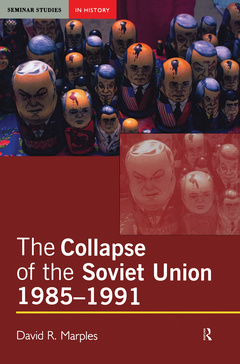The Collapse of the Soviet Union, 1985-1991 Seminar Studies Series
Auteur : Marples David R.

Why did the Soviet Union collapse in 1991?
The collapse of the Soviet Union has widely been seen as the result of the arms race and Cold War, and the failure of the Soviet side to keep pace with new technology. This book argues that the disintegration was mainly a result of two interrelated factors: the rise of the Soviet national republics, and the manipulation of the new Russian presidency by Boris Yeltsin in what became a direct power struggle between Yeltsin and the Soviet leader, Gorbachev.
Written in a clear and accessible manner, the book provides:
- an explanation of how the national question came to dominate Soviet politics by 1990-1
- analysis of the economic crisis that occurred in the late 1980s
- a chapter devoted to the year 1991, from the referendum to reform the Soviet Union to the unforeseen dissolution of the country by December
- a discussion of the personalities of and political confrontation between the two key statesman: Gorbachev and Yeltsin
Also containing a Chronology, Glossary and Who's Who of key figures, The Collapse of the Soviet Union is essential reading for students of twentieth century European history.
INTRODUCTION
PART ONE: BACKGROUND
1. GORBACHEV COMES TO POWER
Political Overview
Glasnost
Social, Environmental, and Nuclear Power Issues
PART TWO: THE YEARS OF PERESTROIKA
2. THE ECONOMY AND FOREIGN POLICY
The Economy, 1985-90
Acceleration and Anti-Alcohol Campaigns
Coal Miners’ Strike
Economic Reform Programmes
Stagnation
The Pavlov Programme
Foreign Policy
Ideology and Propaganda
Arms Control
Architects of Soviet Foreign Policy
Eastern Europe
Ending the Cold War
3. THE NATIONAL QUESTION
The Submerged Dilemma
Nagorno-Katabakh
The Baltic States
Georgia, Ukraine, and Belarus
The Plenum on National Policy, September 1989
4. DOMESTIC POLITICS, 1989-MID-AUGUST 1991
The Congress of People’s Deputies and New Presidency
The 28th Party Congress and Aftermath
The Referendum of 17 March 1991
Toward a New Union Treaty
5. THE PUTSCH AND THE COLLAPSE OF THE USSR
The Putsch, 18-21 August 1991
Administrative Changes
The Failure of the Union Treaty
Yeltsin Consolidates His Power
The Belavezha Agreement
PART THREE: ASSESSMENT
6. WHY DID THE SOVIET UNION COLLAPSE?
PART FOUR: DOCUMENTS
Chronology
Glossary
Who’s Who
Guide to Further Reading
David R. Marples is Professor of History at the University of Alberta.
Date de parution : 10-2015
15.6x23.4 cm
Date de parution : 05-2003
Ouvrage de 160 p.
Thème de The Collapse of the Soviet Union, 1985-1991 :
Mots-clés :
supreme; aleksandr; yakovlev; sovetskaya; rossiya; leadership; ussr; yegor; boris; yeltsin; USSR Supreme Soviet; Sovetskaya Rossiya; Young Men; GDR; UN; RSFSR Supreme Soviet; Supreme Soviet; Mikhail Sergeevich Gorbachev; Cc CPSU; Vladimir Kryuchkov; Russian Federation; USSR Cabinet; Belarusian Popular Front; USSR President; Violated; Aleksandr Yakovlev; West Germany; Follow; Tv Tower; Draft Union Treaty; Belarusian Soviet Socialist Republics; Lithuanian Supreme Soviet; Gorbachev; Mikhail Gorbachev; Nep Period



